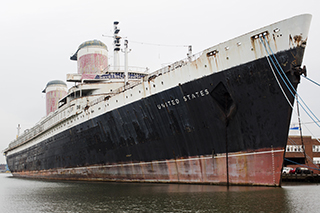Saved from the shipbreakers by a last-minute fundraising drive, the iconic ocean liner SS United States may be headed for its old port of call: the New York City’s Hudson River piers, where the SS United States Conservancy has scheduled a Feb. 4 press conference. A report on Philly.com Thursday suggested the event at the Manhattan Cruise Terminal on Pier 88 could be a signal the nonprofit group is close to achieving its goal of a permanent home, restoration and re-use of the 990’x101’ liner, the pride of the U.S. merchant fleet in the 1950s, but an endangered derelict since it was tied up in Philadelphia in 1996.
Backers warned they were at a crisis point in October, after burning through $60,000 a month in moorage, insurance and other costs.
But in late November, the conservancy announced three major angels had come forward, along with other donors: Richard O’Leary, a former deck officer on the liner, who gave $100,000, longtime cruise industry executive Jim Pollin who gave $100,000 in addition to his earlier donations, and an anonymous donor who ponied up $250,000. In all, it was enough to buy a 10-month reprieve.
Conservancy officials said they will describe "an option agreement with a redevelopment partner" at the Feb. 4 event.
Entering service in 1952, the 43,500-ton liner cruised at 30.5 knots and could dash at over 38 knots, powered by eight Iowa-class Babcock & Wilcox boilers and Westinghouse geared steam turbines. Subsidized by the U.S. government, the vessel was capable of conversion to a troopship. If the Cold War in Europe went hot, defense planners thought, the United States would be able to outrun danger from Soviet submarines. At less than two-thirds speed, the Atlantic crossing took three and a half days. In the 1950s, the liner was a preferred conveyance for the rich and famous, with passenger lists that counted Marilyn Monroe, Marlon Brando and Duke Ellington.
But along with the rest of the trans-Atlantic liner industry, the United States just couldn’t compete with the growing airline industry, and it went out of service in 1969. A series of moves ended on the Delaware riverfront in Philadelphia, where in 1996 one city official said the dilapidated ship and its dubious prospects meant it "could very easily be the largest abandoned vehicle in the city.”
Proposals over the years have envisioned dedicated the restored ship as a monument to American technological prowess, with its educational mission combined with creative commercial use such as hotel or tech businesses. In 2014 conservancy officials said they were close to a move to New York. The press event could be a sign that may finally happen.





